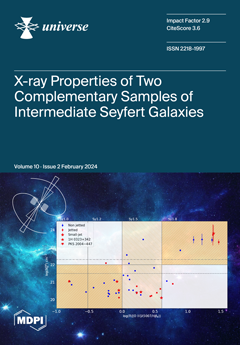We construct and analyze a model of a neutron star in a
-deformed space-time. This is conducted by first deriving the
-deformed generalization of the Einstein tensor, starting from the non-commutative generalization of the metric tensor. By generalizing the energy-momentum tensor
[...] Read more.
We construct and analyze a model of a neutron star in a
-deformed space-time. This is conducted by first deriving the
-deformed generalization of the Einstein tensor, starting from the non-commutative generalization of the metric tensor. By generalizing the energy-momentum tensor to the non-commutative space-time and exploiting the
-deformed dispersion relation, we then set up Einstein’s field equations in the
-deformed space-time. As we adopt a realization of the non-commutative coordinates in terms of the commutative coordinates and their derivatives, our model is constructed in terms of commutative variables. Using this, we derive the
-deformed generalization of the Tolman–Oppenheimer–Volkoff equation. Now, by treating the interior of the star as a perfect fluid as in the commutative space-time, we investigate the modification of the neutron star’s mass due to the non-commutativity of space-time, valid up to first order in the deformation parameter. We show that the non-commutativity of space-time enhances the mass limit of the neutron star. We show that the radius and maximum mass of the neutron star depend on the deformation parameter. Further, our study shows that the mass increases as the radius increases for fixed values of the deformation parameter. We show that maximum mass and radius increase as the deformation parameter increases. We find that the mass varies from
to
as the radius changes from
km to
km. Using the recent observational limits on the upper bound of the mass of a neutron star, we find the deformation parameter to be
m. We also show that the compactness and surface redshift of the neutron star increase with its mass.
Full article





